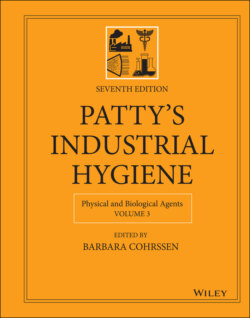Читать книгу Patty's Industrial Hygiene, Physical and Biological Agents - Группа авторов - Страница 50
10.1 Geiger–Muller (G–M) Counters
ОглавлениеGeiger counters are among the most used and the oldest of all the portable survey instruments. This popularity is due to their relative simplicity, which makes them comparatively inexpensive, and to their wide range of usefulness. G–M counters are available in a variety of sizes and shapes, and they can be designed to respond to alpha, beta, and gamma radiations by varying the choices of window thickness and wall thickness. For detecting alpha and low‐energy beta particles, the window through which the radiation must pass in order to get into the counter's sensitive volume must be very thin. Geiger counters are very efficient in counting those alphas or betas that get into the sensitive volume. However, the inherent efficiency of G–M counters for gamma rays is very low. Gamma rays are very highly penetrating and thus can easily pass through the sensitive volume in a G–M tube. Use of a relatively thick‐walled G–M tube greatly increases its sensitivity for gamma rays. The gamma ray interacts with the thick wall by knocking an electron out of one of its atoms. The free electron then enters into the tube's sensitive volume and triggers the counting mechanism. Of course, if the wall is too thick, the electron will not reach the sensitive volume, and the photon will not be counted. It is thus seen that the radiation response of G–M counters is energy dependent. Therefore, two factors in the choice of a G–M instrument are the type and energy of radiation to be detected.
There is a finite time after a particle is counted, called the resolving time, during which the G–M counter will not respond to a second particle. For G–M counters, the resolving time is ∼100 μs. If particles enter the counter at a faster rate than can be resolved, then the counter becomes paralyzed, and the meter reading falls to zero. Therefore, the counter should be turned on before entering a radiation area. If there is a very high radiation field, then the counter will respond, and the count rate will continue to increase (thereby signaling the surveyor of the possible very high radiation level) until it becomes paralyzed. Thus, the radiation level at which the counter becomes paralyzed is an important parameter in choosing an instrument. Modern instruments typically cannot be paralyzed, but this should be verified prior to use.
Another important parameter in choosing or in using a portable surveying instrument is the instrument's response time. A finite time is required for the meter to give the true value of the radiation field. This response time is determined by the time constant of instrument's electronic circuitry. The time constant is defined as the time required for the meter reading to achieve 63% of its final reading. Thus, the instrument must be exposed to the radiation field for several time constants in order to obtain a true measurement of the radiation field. This is of importance when scanning an area too quickly, or in measuring radiation fields of short duration. The time constant for most instruments is on the order of several seconds. Furthermore, if a surveying instrument has several ranges, the time constant increases as the sensitivity of the instrument increases. This consideration is significant, for example in measuring the radiation level from a dental or diagnostic medical X‐ray machine at the technician's position because the X‐ray exposure is only a small fraction of a second. In this case, the meter would read much less than the true radiation level. Because of the inertia in the metering system of a G–M counter, most Geiger counters have an audio output that is not limited by the meter's time constant. It is therefore imperative that the health physics surveyor use the audio output, either through earphones or through a loudspeaker that is incorporated into many monitoring and surveying instruments.
A G–M counter is not designed for measuring radiation dose. However, it may be used for dosimetry only for the radiation energy or for the isotope for which it has been calibrated. Typical full‐scale readings of portable G–M survey meters are about 500–50 000 counts per minute, or (when calibrated with 60Co or 137Cs) 0.1–10 mrad h−1.
